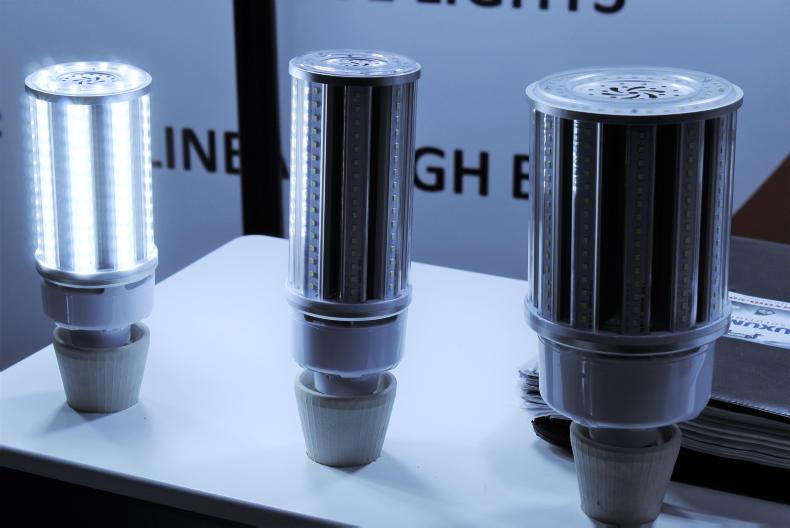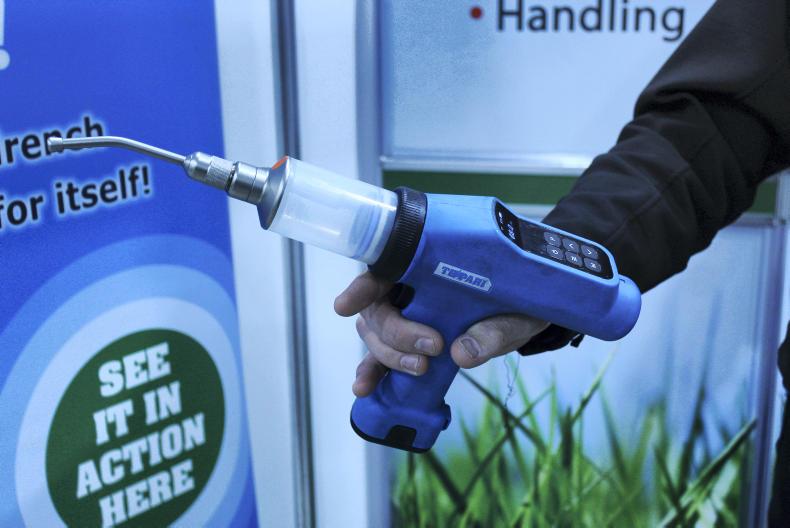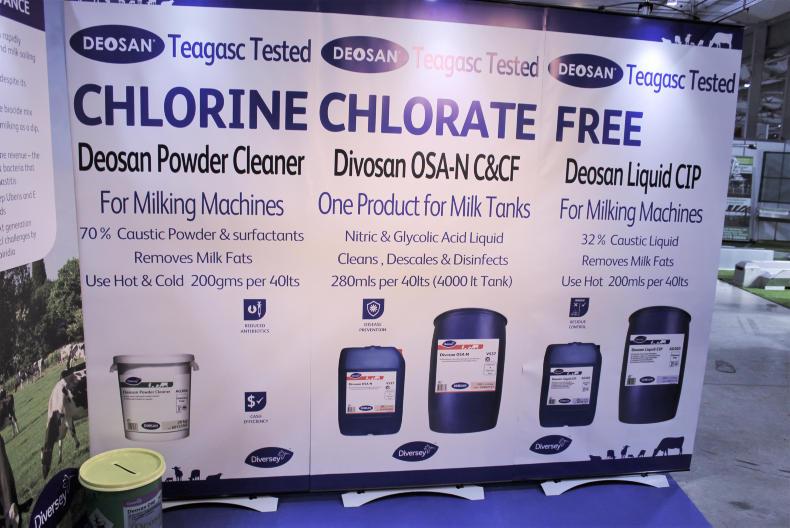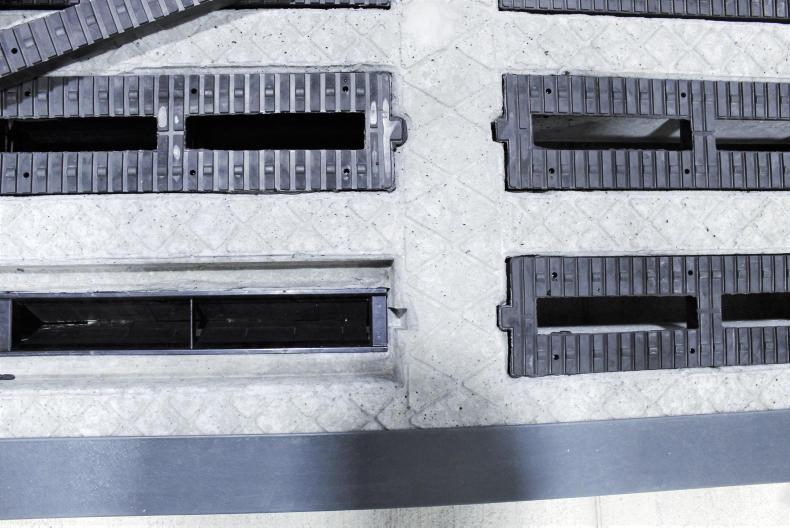With farming coming under increasing pressure from environmental, food safety and animal welfare lobby groups, there were multiple stands at last week’s Winter Fair offering dairy farmers solutions to address some of these concerns.
In many cases, the products on display are new to the market in 2019.
Picture 1: Hybrid slats
One of the more innovative products was the hybrid slat manufactured by Wright Quarry Products.
The ECO-Floor slat is 50% concrete and 50% rubber and improves cow traction. Both surfaces are grooved to increase urine and faeces run-off to storage tanks, limiting the potential for urine and faeces to mix, which leads to the release of ammonia gas.
This also leaves a drier floor, thereby reducing lameness.
The rubber is reinforced with glass fibre and can be removed and replaced. Below the surface of the rubber slat is a valve which again cuts ammonia losses from underground storage tanks.
Picture 2: Magellan rubber flooring

Picture 2 - Magellan flooring.
An alternative floor option to cut down ammonia loss is the Magellan system from Teemore Engineering. It has a series of channels which separate urine and liquid faeces, keeping the cow’s feet dry and giving added traction. The manufacturer claims the products can cut ammonia emissions by up to 40%.
Picture 3: 360° LED lighting

Picture 3 - LED lighting.
LED lighting in cattle housing can cut energy use by 80% over traditional tube or sulphur filament lights.
New designs are available with include 360° bulbs from 24 to 125 Watts. The lights come with dimmer settings, allowing further power savings.
Picture 4: Smart
dosing gun

Picture 4 - Smart dosing gun.
The TEPARI dosing gun links with EID handling systems via Bluetooth. The gun can be used as a conventional dosing applicator, but its primary purpose is to administer the correct dosage to every animal passing through a race.
As cattle are weighed, the gun recalibrates, based on the product guidelines. This cuts down on over and under-dosing, reducing the likelihood of drug resistance.
Part 5: Charriau tube milk cooler

Picture 5 - Milk cooling system.
A new product for cooling milk is a spiral tubed system. The product manufacturer claims it will cut energy use by 60% over conventional plate coolers. It is also designed to increase milk hygiene as it is easier to clean and maintain, with no filters required.
The system works with two coiled tubes, which can be increased to five, and is able to handle up to 2,000l of milk per hour.
Picture 6: RAMGen
silage cover

Picture 6 - Silage cover.
The award-winning silage cover design from RAMGen is designed to take the hassle out of covering the pit.
The product does not require used tyres, or weight bags, to anchor the top sheet.
It works by using the weight of ensiled grass at the sides of the clamp to hold the cover in place. It is then joined in the middle using a series of ratchets, which are tensioned to apply pressure to the clamp. Once grass settles, the cover can be tightened further.
Picture 7: Chlorine-free disinfectants

Picture 7 - Chlorine-free disinfectant.
Chlorine residues in milk are a growing issue, with some processors already requiring suppliers not to use chlorinated products when washing parlours and bulk tanks. Some exhibitors had chlorine-free products on display which have been successfully tested on Irish farms.
Read more
Winter Fair: how much for a cubicle sweeper?
Limerick breeder takes interbreed title at Winter Fair
With farming coming under increasing pressure from environmental, food safety and animal welfare lobby groups, there were multiple stands at last week’s Winter Fair offering dairy farmers solutions to address some of these concerns.
In many cases, the products on display are new to the market in 2019.
Picture 1: Hybrid slats
One of the more innovative products was the hybrid slat manufactured by Wright Quarry Products.
The ECO-Floor slat is 50% concrete and 50% rubber and improves cow traction. Both surfaces are grooved to increase urine and faeces run-off to storage tanks, limiting the potential for urine and faeces to mix, which leads to the release of ammonia gas.
This also leaves a drier floor, thereby reducing lameness.
The rubber is reinforced with glass fibre and can be removed and replaced. Below the surface of the rubber slat is a valve which again cuts ammonia losses from underground storage tanks.
Picture 2: Magellan rubber flooring

Picture 2 - Magellan flooring.
An alternative floor option to cut down ammonia loss is the Magellan system from Teemore Engineering. It has a series of channels which separate urine and liquid faeces, keeping the cow’s feet dry and giving added traction. The manufacturer claims the products can cut ammonia emissions by up to 40%.
Picture 3: 360° LED lighting

Picture 3 - LED lighting.
LED lighting in cattle housing can cut energy use by 80% over traditional tube or sulphur filament lights.
New designs are available with include 360° bulbs from 24 to 125 Watts. The lights come with dimmer settings, allowing further power savings.
Picture 4: Smart
dosing gun

Picture 4 - Smart dosing gun.
The TEPARI dosing gun links with EID handling systems via Bluetooth. The gun can be used as a conventional dosing applicator, but its primary purpose is to administer the correct dosage to every animal passing through a race.
As cattle are weighed, the gun recalibrates, based on the product guidelines. This cuts down on over and under-dosing, reducing the likelihood of drug resistance.
Part 5: Charriau tube milk cooler

Picture 5 - Milk cooling system.
A new product for cooling milk is a spiral tubed system. The product manufacturer claims it will cut energy use by 60% over conventional plate coolers. It is also designed to increase milk hygiene as it is easier to clean and maintain, with no filters required.
The system works with two coiled tubes, which can be increased to five, and is able to handle up to 2,000l of milk per hour.
Picture 6: RAMGen
silage cover

Picture 6 - Silage cover.
The award-winning silage cover design from RAMGen is designed to take the hassle out of covering the pit.
The product does not require used tyres, or weight bags, to anchor the top sheet.
It works by using the weight of ensiled grass at the sides of the clamp to hold the cover in place. It is then joined in the middle using a series of ratchets, which are tensioned to apply pressure to the clamp. Once grass settles, the cover can be tightened further.
Picture 7: Chlorine-free disinfectants

Picture 7 - Chlorine-free disinfectant.
Chlorine residues in milk are a growing issue, with some processors already requiring suppliers not to use chlorinated products when washing parlours and bulk tanks. Some exhibitors had chlorine-free products on display which have been successfully tested on Irish farms.
Read more
Winter Fair: how much for a cubicle sweeper?
Limerick breeder takes interbreed title at Winter Fair












 This is a subscriber-only article
This is a subscriber-only article










SHARING OPTIONS: